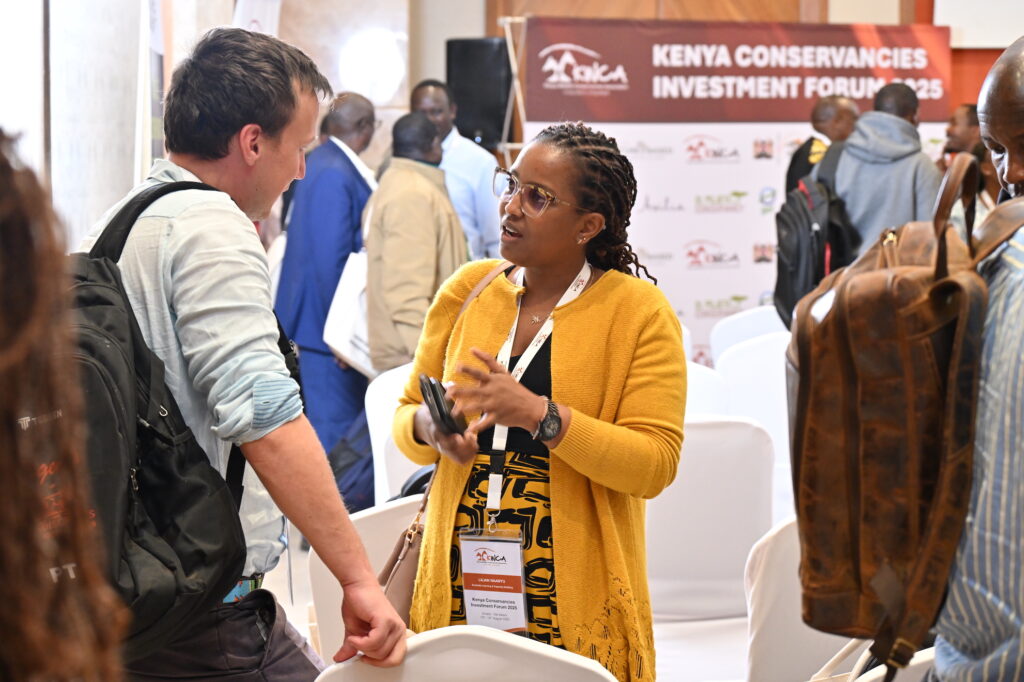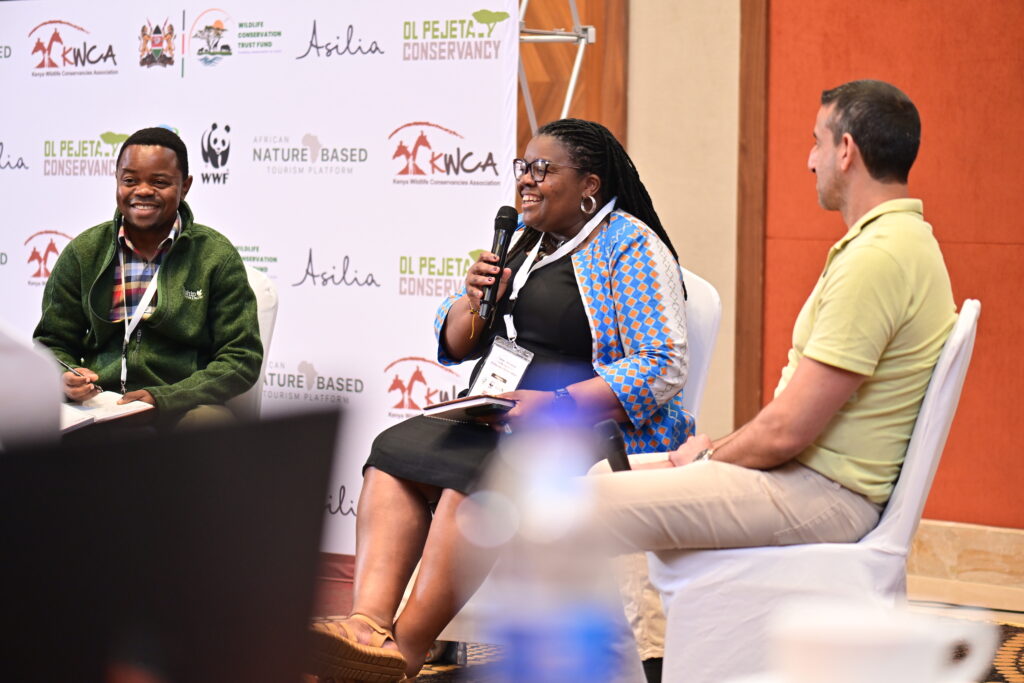Overview
Months of training, business planning, and investment-readiness support culminated this August as Kenya’s community conservancies took center stage at the 2025 Kenya Conservancies Investment Forum. The event showcased how local leaders are turning conservation initiatives into investable ventures that link community prosperity with nature’s protection.
Unlocking Investment Frontiers in Kenya’s Conservancies
Across Kenya, wildlife conservancies are opening new investment frontiers that deliver financial returns while restoring ecosystems and strengthening communities.
This momentum was on full display at the second Kenya Conservancies Investment Forum (KCIF), held in Nairobi in August 2025. Organized by the Kenya Wildlife Conservancies Association (KWCA) with support from WWF-US through its GEF-funded African Nature-Based Tourism Platform (ANBTP), the forum brought together conservation leaders, investors, government representatives, and community voices under the theme “Unlocking Investments for Sustainable Conservation.”
With 245 registered conservancies now protecting over 11% of Kenya’s landmass, the event showcased how community-led conservation has become central to biodiversity protection, climate resilience, and rural prosperity.
A Forum Designed for Action
KCIF combined high-level panel discussions with practical investment sessions to turn dialogue into deals. Conservancies presented their business plans directly to potential investors, while sector experts unpacked enabling policies, financing mechanisms, and governance models critical to investment readiness. Structured networking and one-on-one meetings allowed communities and investors to explore specific opportunities—from ecotourism and carbon credits to conservation agriculture, livestock production, and community enterprises such as artisan crafts.

The event served as a regional convening, sharing lessons across borders with partners from Tanzania, Uganda, and Namibia, and highlighting the strong economic incentive: every dollar invested in a conservancy generates an average GDP increase of $1.51, with some returns reaching as high as $20.
Building Capacity for Conservation Investment
The African Nature-Based Tourism Platform (ANBTP), played a central role in readying conservancy members for the event, strategically progressing its work to build resilience around nature-based enterprises. Established to help African countries and communities recover from the devastating impacts of COVID-19 on tourism, over the last 4.5 years, the Platform has helped unlock investments that sustain livelihoods and conserve biodiversity in eleven African countries. Since 2021, it has mobilized more than US$14,112,525 in project funding for conservancies and conservation organizations across eastern and southern Africa using an approach that emphasizes support for initiatives that generate both financial and ecological returns.
“As the national representative body for conservancies, KWCA worked alongside the ANBTP to build local capacity, develop sustainable financing models and connect community-led initiatives with private-sector investment opportunities,” said Vincent Oluoch, KWCA’s lead on private-sector engagement. “If you look at the investments within conservancies, not many have lodges. We are being deliberate in trying to enhance the level of investment in conservancies.”
Several of the investor-ready projects presented at the forum emerged from a structured investment readiness journey supported by the ANBTP. With funding from the Platform, KWCA led the business planning process, contracting social impact design company Alibi Design Ltd. to work with five conservancies to develop detailed, investor-ready business plans. These plans were unveiled on Day 2 of the forum, where Alibi Design shared insights into the development process and key focus areas, including governance, access to private-sector funds, and enabling policies and regulations.
Maurine Nduati of the Taita Taveta Wildlife Conservancies Association appreciated the practical focus of the training, noting: “Conservancies are ready and ripe for investment but have limited platforms for connecting with investors. The Kenya Conservancies Investment Forum has created the opportunity for conservancies and investors to secure these partnerships. However, to make informed investment choices, investors need to visit these conservancies, interact with the communities, and experience nature at its best.”

Strengthening Tourism and Investment Skills
In the months leading up to the forum, NatureScapes, a company specializing in nature tourism development, delivered a six-part webinar series that focused on developing business, tourism, and product development skills with conservancies. The training complemented the later business planning process by helping participants understand and value their natural assets as the foundation for sustainable tourism ventures.
Tailored for those with limited experience in tourism, the series began with an introduction to the sector’s key players and market structures before progressing to models for tourism within conservancies and protected areas. Participants learned to map and inventory tourism assets, assess market potential, and identify viable investment opportunities — skills often overlooked in early-stage planning.
Wilson Kandip from Sinibo Geo Park Community Conservancy noted how useful it was to gain “product knowledge about tourism,” that he can share with his community, saying he can now confidently “explain to the community all the benefits of, and interest [in tourism] in the area” as they develop their offerings as a conservancy.
Simon Jones, founder of NatureScapes, emphasized the broader role of tourism saying: “Many of you [course participants], including us as an organization, see tourism as a tool to other things. It’s good to take a step back and think about who the visitor is, but also what you want out of developing tourism in your destination — whether economic development, community development, conservation, or a combination of all of those.”
By combining business planning, financial literacy, and tourism development training, the ANBTP, KWCA and NatureScapes created a comprehensive pathway for conservancy leaders — transforming local aspirations into actionable, investment-ready business cases.
The following investment-ready opportunities reflect the outcomes of this process, with conservancy visions and voices strengthened through ANBTP-supported training with NatureScapes and business planning with KWCA. Presented at the forum, the business plans highlight how local leaders are using new skills and confidence to turn conservation ambitions into viable enterprises—and how these platforms create vital spaces for communities and investors to connect around shared goals for people and nature.
“When these conservancy representatives stood before investors in Nairobi this August, they weren’t just pitching a tourism idea. They were presenting a business plan months in the making. Each project shows that when communities benefit, conservation becomes both sustainable and desirable,” says WWF’s Nikhil Advani, who leads the ANBTP. “This kind of scaffolding helps connect communities and investors who can explore models that diversify tourism beyond traditional safaris.”

Kikesen River Conservancy: Women-Led Eco-Tourism and Carbon Finance
Kikesen River Conservancy is a pioneering community-owned, women-led eco-tourism and conservation enterprise spanning 11,224 hectares in the Matapato Rangelands of Kajiado Central, Kenya. Strategically located within a vital wildlife corridor linking Amboseli National Park and Lake Magadi, this initiative—defined by its commitment to women’s empowerment, with 80% of operational roles held by local Maasai women—seeks $1.8 million over three years for a three-pillar strategy:
- Constructing 12 solar-powered luxury tented units
- Removing 18 kilometers of fencing to restore wildlife corridors
- Scaling women-led enterprises such as the Eselenkei Grass Seed Bank
Grassland restoration could also generate carbon credits worth up to $1 million per year by year five.
“A main area of interest was how to bring women on board, especially with training…for enterprise development focusing on women, like beadwork curios. We have a rich culture in our village.” — Titus Kila, Kikesen Conservancy.
Meibae Conservancy: High-End Tourism and Holistic Rangeland Management
The Meibae Community Wildlife Conservancy (MCWC) in Samburu County presents an impactful investment opportunity centered on high-end, exclusive eco-tourism within a critical biodiversity hotspot. As one of the few conservancies in Kenya practicing holistic rangeland management, Meibae offers significant conservation value, preserving species such as Grevy’s zebras and African wild dogs.
The Conservancy seeks about $1.7 million to establish a sustainable eco-tourism model that complements its rangeland management program. Plans include constructing a 24-bed luxury lodge with conferencing facilities and renovating an airstrip to improve access for high-value tourism.
The venture is designed for long-term sustainability through solar-powered and water-efficient infrastructure and a commitment to local ownership. The project aims to generate diversified annual revenue streams and create 40 direct jobs for the local Samburu community. Meibae’s democratically elected 16-member board ensures that revenue is reinvested into conservation, education, water, and health care.
“The main thing that’s holding us back is that the Conservancy is a very, very large area and sometimes logistics are difficult, so we have to plan for that. Currently, we only depend on carbon credit money, which goes to operations… It has been a challenge empowering [members]with that small amount of money.”— Julius Letimalo, Meibae Community Wildlife Conservancy.
Shurr Community Conservancy: Locally Owned Sustainable Tourism with High Social Impact
The Shurr Conservancy Eco-Tourism Initiative is a community-driven project in the remote wilderness of Marsabit County, uniquely distinguished by being 100% owned by the local pastoralist communities. This ensures that economic benefits are directly reinvested locally.
The initiative requires $268,000, phased over three years, to construct 10 eco-friendly lodges, implement a targeted marketing strategy, and install renewable energy systems. The project aims to create more than 50 jobs for women and youth by year three and direct 30% of revenue toward education and health care.
“From my thinking, if we really empower women, our conservancy will really go far because if a woman is empowered, everyone at the household level benefits, which is what we want from tourism.”— Umuro Malgis, Marsabit Wildlife Conservancies Association (speaking for Shurr).
Sinibo Geo Park Community Conservancy: Edu-Tourism and Geo-Conservation
The Sinibo Edu-Tourism Initiative in Baringo County is positioning itself as a premium destination that merges UNESCO Geopark-inspired geological exploration with citizen science conservation.
Sinibo aims to capture a share of the $1.9 trillion global educational tourism market, targeting students, eco-tourists, and corporate teams. The initial $320,000 investment focuses on trail infrastructure, an augmented reality mobile app, and training programs for 50 community guides.
“Our objective is to have the administrative office for activities done first… presently, we don’t have an office. Then we are planning to have a lab or an institution for research.” — Wilson Kandip, Sinibo Conservancy.
Kiborit Community Conservancy: Beekeeping and Sustainable Livelihoods
The Kiborit Community Conservancy in Baringo County proposes establishing a modern beekeeping business on its 100 hectares of land to produce high-quality honey, wax, and propolis.
Prepared by Agriwell Ltd. and commissioned by KWCA, the business plan outlines the establishment of 300 modern hives, along with training and marketing initiatives. The business is projected to break even in year two, addressing Kenya’s 40% honey supply deficit and creating a sustainable alternative to livestock and maize farming.
“One of the things that we require from the various organizations, including KWCA is to carry out a lot of participatory [capacity] building for the conservancy so that we have more women being brought to participate.” — Francis Tallam, Kiborit Community Conservancy.

As Kenya’s conservancy movement continues to mature, forums like KCIF are proving vital in transforming community conservation into investable, scalable ventures that deliver tangible benefits for people and nature alike. With growing private-sector confidence and strong community leadership, partnerships like those forged through the ANBTP and KCIF are showing what’s possible when communities lead and investors listen. Together, they are charting a path where conservation drives both livelihoods and long-term economic growth, reminding us that what’s good for people as custodians of nature is good for nature too.

Written by Dianne Tipping-Woods
Zimbabwean-born journalist Dianne Tipping-Woods has spent most of her freelance career looking for stories in southern Africa where travel, conservation and development intersect. She is now based in a nature reserve close to the Kruger National Park in South Africa.
Photo credits: KWCA
October 2025